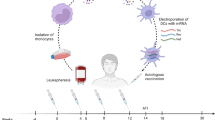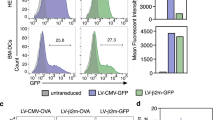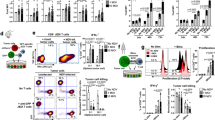Abstract
Delivery of the full-length tumor antigen might be more successful in immunotherapy than single peptides and has the advantage that patients no longer need to be selected for their HLA type. In this study, we tested the in vitro induction of CAMEL/NY-ESO-ORF2-specific T cells by dendritic cells infected with an adenovirus (Ad) type 5 vector containing the fiber shaft and knob of human serotype Ad35 (Ad5F35 vector). Our data show induction of CD8+ T cells specific for the known HLA-A*0201-binding CAMEL/NY-ESO-ORF21–11 epitope by DC infected with Ad5F35-CAMEL, but not by DC pulsed with the recombinant CAMEL protein. In one healthy donor, even CD8+ T cells specific for a new HLA-B7-binding CAMEL/NY-ESO-ORF246–54 epitope were raised. In conclusion, the in vitro induction of CAMEL/NY-ESO-ORF2-specific CD8+ T cells in healthy donors by DC infected with Ad5F35-CAMEL strongly supports further investigation of the Ad5F35 vector as a vehicle for gene transfer into DC for the generation of tumor antigen-specific CD8+ T cell responses in vivo.
This is a preview of subscription content, access via your institution
Access options
Subscribe to this journal
Receive 12 print issues and online access
$259.00 per year
only $21.58 per issue
Buy this article
- Purchase on Springer Link
- Instant access to full article PDF
Prices may be subject to local taxes which are calculated during checkout








Similar content being viewed by others
References
Wang RF, Rosenberg SA . Human tumor antigens for cancer vaccine development. Immunol Rev. 1999;170:85–100.
Cormier JN, Salgaller ML, Prevette T, et al. Enhancement of cellular immunity in melanoma patients immunized with a peptide from MART-1/Melan A. Cancer J Sci Am. 1997;3:37–44.
Jager E, Bernhard H, Romero P, et al. Generation of cytotoxic T cell responses with synthetic melanoma-associated peptides in vivo: implications for tumor vaccines with melanoma-associated antigens. Int J Cancer. 1996;66:162–169.
Nestle FO, Alijagic S, Gilliet M, et al. Vaccination of melanoma patients with peptide- or tumor lysate-pulsed dendritic cells. Nat Med. 1998;4:328–332.
Rosenberg SA, Yang JC, Schwartzentruber DJ, et al. Immunologic and therapeutic evaluation of a synthetic peptide vaccine for the treatment of patients with metastatic melanoma. Nat Med. 1998;4:321–327.
Slingluff Jr CL, Yamshchikov G, Neese P, et al. Phase I trial of a melanoma vaccine with gp100(280–288) peptide and tetanus helper peptide in adjuvant: immunologic and clinical outcomes. Clin Cancer Res. 2001;7:3012–3024.
Lau R, Wang F, Jeffery G, et al. Phase I trial of intravenous peptide-pulsed dendritic cells in patients with metastatic melanoma. J Immunother. 2001;24:66–78.
Scheibenbogen C, Schadendorf D, Bechrakis NE, et al. Effects of granulocyte–macrophage colony-stimulating factor and foreign helper protein as immunologic adjuvants on the T-cell response to vaccination with tyrosinase peptides. Int J Cancer. 2003;104:188–194.
Mukherji B, Chakraborty NG, Yamasaki S, et al. Induction of antigen-specific cytolytic T cells in situ in human melanoma by immunization with synthetic peptide-pulsed autologous antigen presenting cells. Proc Natl Acad Sci USA. 1995;92:8078–8082.
Hu X, Chakraborty NG, Sporn JR, et al. Enhancement of cytolytic T lymphocyte precursor frequency in melanoma patients following immunization with the MAGE-1 peptide loaded antigen presenting cell-based vaccine. Cancer Res. 1996;56:2479–2483.
Marchand M, van Baren N, Weynants P, et al. Tumor regressions observed in patients with metastatic melanoma treated with an antigenic peptide encoded by gene MAGE-3 and presented by HLA-A1. Int J Cancer. 1999;80:219–230.
Thurner B, Haendle I, Roder C, et al. Vaccination with Mage-3A1 peptide-pulsed mature, monocyte-derived dendritic cells expands specific cytotoxic T cells and induces regression of some metastases in advanced stage IV melanoma. J Exp Med. 1999;190:1669–1678.
Gnjatic S, Jager E, Chen W, et al. CD8(+) T cell responses against a dominant cryptic HLA-A2 epitope after NY-ESO-1 peptide immunization of cancer patients. Proc Natl Acad Sci USA. 2002;99:11813–11818.
Meidenbauer N, Marienhagen J, Laumer M, et al. Survival and tumor localization of adoptively transferred Melan-A-specific T cells in melanoma patients. J Immunol. 2003;170:2161–2169.
Yee C, Thompson JA, Byrd D, et al. Adoptive T cell therapy using antigen-specific CD8+ T cell clones for the treatment of patients with metastatic melanoma: in vivo persistence, migration, and antitumor effect of transferred T cells. Proc Natl Acad Sci USA. 2002;99:16168–16173.
Ossendorp F, Mengede E, Camps M, et al. Specific T helper cell requirement for optimal induction of cytotoxic T lymphocytes against major histocompatibility complex class II negative tumors. J Exp Med. 1998;187:693–702.
Schoenberger SP, Toes RE, van der Voort EI, et al. T-cell help for cytotoxic T lymphocytes is mediated by CD40–CD40L interactions. Nature. 1998;393:480–483.
Bennett SR, Carbone FR, Karamalis F, et al. Help for cytotoxic-T-cell responses is mediated by CD40 signalling. Nature. 1998;393:478–480.
Ridge JP, Di Rosa F, Matzinger P . A conditioned dendritic cell can be a temporal bridge between a CD4+ T-helper and a T-killer cell. Nature. 1998;393:474–478.
Butterfield LH, Jilani SM, Chakraborty NG, et al. Generation of melanoma-specific cytotoxic T lymphocytes by dendritic cells transduced with a MART-1 adenovirus. J Immunol. 1998;161:5607–5613.
Linette GP, Shankara S, Longerich S, et al. In vitro priming with adenovirus/gp100 antigen-transduced dendritic cells reveals the epitope specificity of HLA-A*0201-restricted CD8+ T cells in patients with melanoma. J Immunol. 2000;164:3402–3412.
Ribas A, Butterfield LH, McBride WH, et al. Genetic immunization for the melanoma antigen MART-1/Melan-A using recombinant adenovirus-transduced murine dendritic cells. Cancer Res. 1997;57:2865–2869.
Kaplan JM, Yu Q, Piraino ST, et al. Induction of antitumor immunity with dendritic cells transduced with adenovirus vector-encoding endogenous tumor-associated antigens. J Immunol. 1999;163:699–707.
Bergelson JM, Cunningham JA, Droguett G, et al. Isolation of a common receptor for coxsackie B viruses and adenoviruses 2 and 5. Science. 1997;275:1320–1323.
Segerman A, Mei YF, Wadell G . Adenovirus types 11p and 35p show high binding efficiencies for committed hematopoietic cell lines and are infective to these cell lines. J Virol. 2000;74:1457–1467.
Rea D, Havenga MJ, van den Assem M, et al. Highly efficient transduction of human monocyte-derived dendritic cells with subgroup B fiber-modified adenovirus vectors enhances transgene-encoded antigen presentation to cytotoxic T cells. J Immunol. 2001;166:5236–5244.
Havenga MJ, Lemckert AA, Ophorst OJ, et al. Exploiting the natural diversity in adenovirus tropism for therapy and prevention of disease. J Virol. 2002;76:4612–4620.
Chirmule N, Propert K, Magosin S, et al. Immune responses to adenovirus and adeno-associated virus in humans. Gene Therapy. 1999;6:1574–1583.
Molnar-Kimber KL, Sterman DH, Chang M, et al. Impact of preexisting and induced humoral and cellular immune responses in an adenovirus-based gene therapy phase I clinical trial for localized mesothelioma. Hum Gene Ther. 1998;9:2121–2133.
Gahery-Segard H, Farace F, Godfrin D, et al. Immune response to recombinant capsid proteins of adenovirus in humans: antifiber and anti-penton base antibodies have a synergistic effect on neutralizing activity. J Virol. 1998;72:2388–2397.
Wohlfart C . Neutralization of adenoviruses: kinetics, stoichiometry, and mechanisms. J Virol. 1988;62:2321–2328.
Flomenberg PR, Chen M, Munk G, et al. Molecular epidemiology of adenovirus type 35 infections in immunocompromised hosts. J Infect Dis. 1987;155:1127–1134.
Aarnoudse CA, van den Doel PB, Heemskerk B, et al. Interleukin-2-induced, melanoma-specific T cells recognize CAMEL, an unexpected translation product of LAGE-1. Int J Cancer. 1999;82:442–448.
Lethe B, Lucas S, Michaux L, et al. LAGE-1, a new gene with tumor specificity. Int J Cancer. 1998;76:903–908.
Chen YT, Scanlan MJ, Sahin U, et al. A testicular antigen aberrantly expressed in human cancers detected by autologous antibody screening. Proc Natl Acad Sci USA. 1997;94:1914–1918.
Rimoldi D, Rubio-Godoy V, Dutoit V, et al. Efficient simultaneous presentation of NY-ESO-1/LAGE-1 primary and nonprimary open reading frame-derived CTL epitopes in melanoma. J Immunol. 2000;165:7253–7261.
Wang RF, Johnston SL, Zeng G, et al. A breast and melanoma-shared tumor antigen: T cell responses to antigenic peptides translated from different open reading frames. J Immunol. 1998;161:3598–3606.
Slager EH, Borghi M, van der Minne CE, et al. CD4(+) Th2 cell recognition of HLA-DR-restricted epitopes derived from CAMEL: a tumor antigen translated in an alternative open reading frame. J Immunol. 2003;170:1490–1497.
Havenga MJ, Lemckert AA, Grimbergen JM, et al. Improved adenovirus vectors for infection of cardiovascular tissues. J Virol. 2001;75:3335–3342.
Shabram PW, Giroux DD, Goudreau AM, et al. Analytical anion-exchange HPLC of recombinant type-5 adenoviral particles. Hum Gene Ther. 1997;8:453–465.
He TC, Zhou S, da-Costa LT, et al. A simplified system for generating recombinant adenoviruses. Proc Natl Acad Sci USA. 1998;95:2509–2514.
Griffioen M, Borghi M, Schrier PI, et al. Detection and quantification of CD8(+) T cells specific for HLA-A*0201- binding melanoma and viral peptides by the IFN-gamma-ELISPOT assay. Int J Cancer. 2001;93:549–555.
Gnjatic S, Atanackovic D, Matsuo M, et al. Cross-presentation of HLA class I epitopes from exogenous NY-ESO-1 polypeptides by nonprofessional APCs. J Immunol. 2003;170:1191–1196.
Eberl G, Renggli J, Men Y, et al. Extracellular processing and presentation of a 69-mer synthetic polypetide to MHC class I-restricted T cells. Mol Immunol. 1999;36:103–112.
Marzo AL, Kinnear BF, Lake RA, et al. Tumor-specific CD4+ T cells have a major “post–licensing” role in CTL mediated anti-tumor immunity. J Immunol. 2000;165:6047–6055.
Tuettenberg A, Jonuleit H, Tuting T, et al. Priming of T cells with Ad-transduced DC followed by expansion with peptide-pulsed DC significantly enhances the induction of tumor-specific CD8(+) T cells: implications for an efficient vaccination strategy. Gene Therapy. 2003;10:243–250.
Kuball J, Schuler M, Antunes FE, . Generating p53-specific cytotoxic T lymphocytes by recombinant adenoviral vector-based vaccination in mice, but not man. Gene Therapy. 2002;9:833–843.
Acknowledgements
We thank A Zakhartchouk for cloning the measles antigen into Ad vectors and subsequent generation and in vitro testing of recombinant viruses carrying CAMEL antigen. We also thank B Vogelstein for providing the plasmids required for generation of the Ad5 vectors and RC Hoeben for propagating the Ad5 vectors encoding LAGE-1 and NY-ESO-1 on PER.C6TM. CAM van Bergen and JHF Falkenburg are gratefully acknowledged for in vitro experiments with purified proteasomes.
Author information
Authors and Affiliations
Corresponding author
Rights and permissions
About this article
Cite this article
Slager, E., van der Minne, C., Goudsmit, J. et al. Induction of CAMEL/NY-ESO-ORF2-specific CD8+ T cells upon stimulation with dendritic cells infected with a modified Ad5 vector expressing a chimeric Ad5/35 fiber. Cancer Gene Ther 11, 227–236 (2004). https://doi.org/10.1038/sj.cgt.7700674
Received:
Published:
Issue Date:
DOI: https://doi.org/10.1038/sj.cgt.7700674
Keywords
This article is cited by
-
Molecular and immunological evaluation of the expression of cancer/testis gene products in human colorectal cancer
Cancer Immunology, Immunotherapy (2007)
-
A new LAGE-1 peptide recognized by cytolytic T lymphocytes on HLA-A68 tumors
Cancer Immunology, Immunotherapy (2006)



